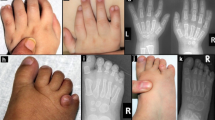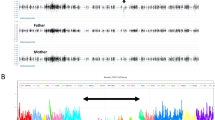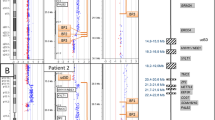Abstract
Several cases with microscopically visible, terminal 6p deletions have been described, and a distinct clinical phenotype has emerged, including developmental delay, congenital heart malformations, ocular abnormalities, hearing loss and a characteristic facial appearance. We report a patient with a submicroscopic 6p deletion, detected by subtelomeric screening using fluorescence in situ hybridisation. This girl presented with typical facial dysmorphic features, hearing impairment, malformation of the anterior eye segment, an ASD and severe language impairment. However, her cognitive functions were within the normal range. Detailed FISH analysis with 20 BAC probes covering the distal 6p25 region estimated the size of the terminal deletion to 2.1 Mb, and thus this case narrows down the critical region for the 6p phenotype. The forkhead transcription factor gene FOXC1, involved in a spectrum of anterior eye chamber disorders, is deleted in this patient, together with several characterised and putative genes with yet unknown function.
Similar content being viewed by others
Log in or create a free account to read this content
Gain free access to this article, as well as selected content from this journal and more on nature.com
or
References
Palmer CG, Bader P & Slovak ML et al: Partial deletion of chromosome 6p: delineation of the syndrome. Am J Med Genet 1991; 39: 155–160.
Davies AF, Olavesen MG, Stephens RJ, Comings DE & Pettenati MJ : A detailed investigation of two cases exhibiting characteristics of the 6p deletion syndrome. Hum Genet 1996; 98: 454–459.
Davies AF, Mirza G & Sekhon G et al: Delineation of two distinct 6p deletion syndromes. Hum Genet 1999; 104: 64–72.
Knight SJ, Regan R & Nicod A et al: Subtle chromosomal rearrangements in children with unexplained mental retardation. Lancet 1999; 354: 1676–1681.
Law CJ, Fisher AM & Temple IK : Distal 6p deletion syndrome: a report of a case with anterior chamber eye anomaly and review of published reports. J Med Genet 1998; 35: 685–689.
Kaufmann E & Knochel W : Five years on the wings of fork head. Mech Dev 1996; 57: 3–20.
Prueitt RL & Zinn AR : A fork in the road to fertility. Nat Genet 2001; 27: 132–134.
Nishimura DY, Searby CC & Alward WL et al: A spectrum of FOXC1 mutations suggests gene dosage as a mechanism for developmental defects of the anterior chamber of the eye. Am J Hum Genet 2001; 68: 364–372.
Smith RS, Zabaleta A & Kume T et al: Haploinsufficiency of the transcription factors FOXC1 and FOXC2 results in aberrant ocular development. Hum Mol Genet 2000; 9: 1021–1032.
Clifton-Bligh RJ, Wentworth JM & Heinz P et al: Mutation of the gene encoding human TTF-2 associated with thyroid agenesis, cleft palate and choanal atresia. Nat Genet 1998; 19: 399–401.
Fang J, Dagenais SL & Erickson RP et al: Mutations in FOXC2 (MFH-1), a forkhead family transcription factor, are responsible for the hereditary lymphedema-distichiasis syndrome. Am J Hum Genet 2000; 67: 1382–1388.
Crisponi L, Deiana M & Loi A et al: The putative forkhead transcription factor FOXL2 is mutated in blepharophimosis/ptosis/epicanthus inversus syndrome. Nat Genet 2001; 27: 159–166.
Mears AJ, Jordan T & Mirzayans F et al: Mutations of the forkhead/winged-helix gene, FKHL7, in patients with Axenfeld-Rieger anomaly. Am J Hum Genet 1998; 63: 1316–1328.
Nishimura DY, Swiderski RE & Alward WL et al: The forkhead transcription factor gene FKHL7 is responsible for glaucoma phenotypes which map to 6p25. Nat Genet 1998; 19: 140–147.
Lai CS, Fisher SE, Hurst JA, Vargha-Khadem F & Monaco AP : A forkhead-domain gene is mutated in a severe speech and language disorder. Nature 2001; 413: 519–523.
Fisher SE, Vargha-Khadem F, Watkins KE, Monaco AP & Pembrey ME : Localisation of a gene implicated in a severe speech and language disorder. Nat Genet 1998; 18: 168–170.
Aitola M, Carlsson P, Mahlapuu M, Enerbäck S & Pelto-Huikko M : Forkhead transcription factor FoxF2 is expressed in mesodermal tissues involved in epithelio-mesenchymal interactions. Dev Dyn 2000; 218: 136–149.
Grossman A, Mittrucker HW & Nicholl J et al: Cloning of human lymphocyte-specific interferon regulatory factor (hLSIRF/hIRF4) and mapping of the gene to 6p23-p25. Genomics 1996; 37: 229–233.
Smith A, Price C & Cullen M et al: Chromosomal localization of three human dual specificity phosphatase genes (DUSP4, DUSP6, and DUSP7). Genomics 1997; 42: 524–527.
Acknowledgements
We thank Prof M Rocchi, Resources for Molecular Cytogenetics, BARI and the Sanger Centre for supplying BAC-probes. This work was supported by funds from the Swedish Medical Research Council, Frimurarna Barnahuset Foundation, Ronald McDonald Child Foundation and Sunnerdahl Foundation.
Author information
Authors and Affiliations
Corresponding author
Rights and permissions
About this article
Cite this article
Anderlid, BM., Schoumans, J., Hallqvist, Å. et al. Cryptic subtelomeric 6p deletion in a girl with congenital malformations and severe language impairment. Eur J Hum Genet 11, 89–92 (2003). https://doi.org/10.1038/sj.ejhg.5200907
Received:
Revised:
Accepted:
Published:
Issue date:
DOI: https://doi.org/10.1038/sj.ejhg.5200907
Keywords
This article is cited by
-
Partial Trisomy of Chromosome 8q and Partial Monosomy of Chromosome 6p with Robinow Syndrome-Like Phenotype
Indian Journal of Pediatrics (2021)
-
Haploinsufficiency and triploinsensitivity of the same 6p25.1p24.3 region in a family
BMC Medical Genomics (2015)
-
Genetic insights into the functional elements of language
Human Genetics (2013)
-
PITX2 and FOXC1 spectrum of mutations in ocular syndromes
European Journal of Human Genetics (2012)
-
Deletions in chromosome 6p22.3-p24.3, including ATXN1, are associated with developmental delay and autism spectrum disorders
Molecular Cytogenetics (2012)



